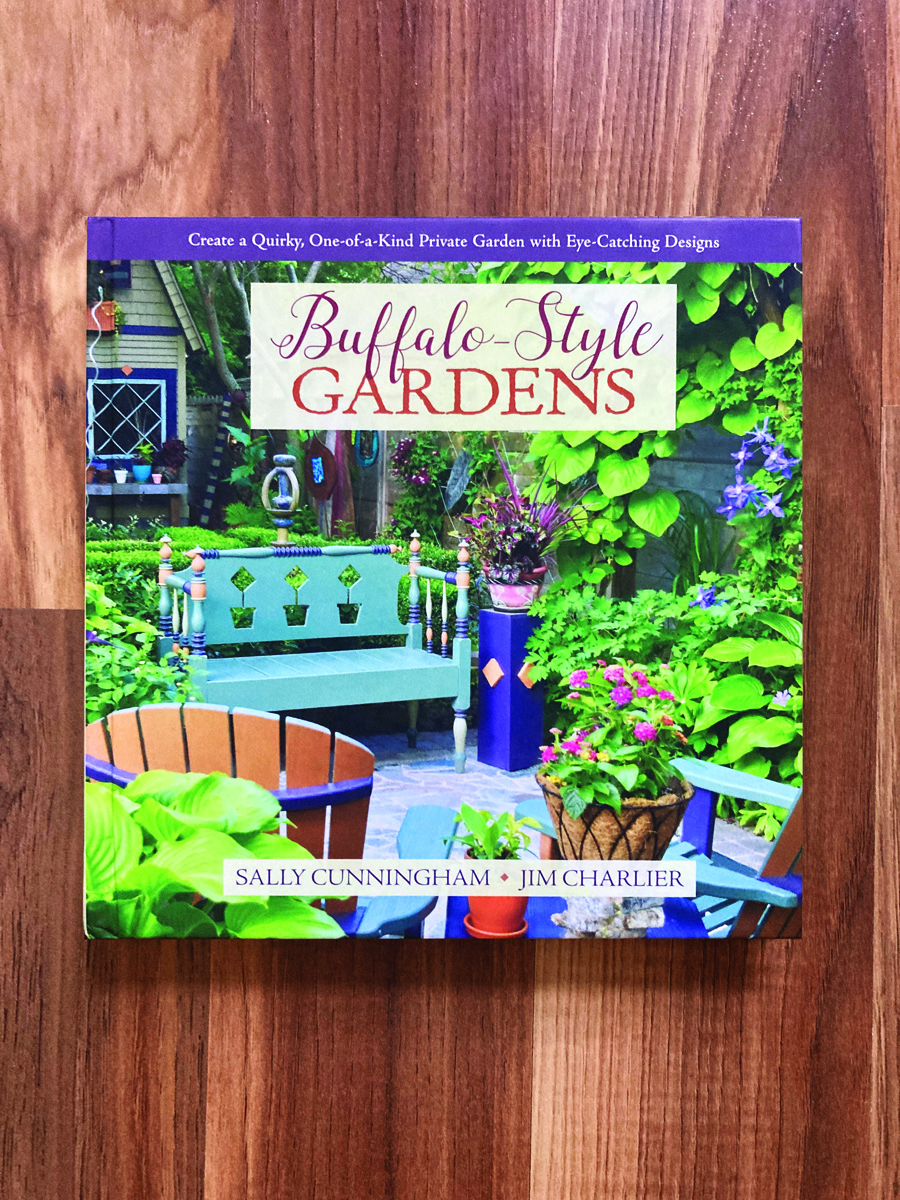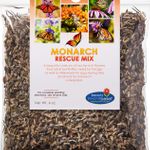
Today’s photos are from Steve in Southern California.
You featured my garden some years back (A Drought-Tolerant California Garden), and I thought your visitors might like to see some updates from around the garden, especially this year, with all of the weather everyone keeps hearing about in Southern California.
I live right in the heart of L.A., in an area many people have heard of called Laurel Canyon, which is a block or tel from my home. I live in a little subvalley, if you will, the last little pocket before Studio City and the San Fernando Valley sprawl beyond. It is a place with a small creek that runs in a year like this, where we might get frogs at night soon and the crickets protest most loudly in August. For a gardener like me, the fun is attracting all the visitors to the garden, and I’ve focused on native plants and trees to do that, but also on all the other items like host plants, nest-building plants, edible berries, etc.
 This Cereus peruvianus (Zones 9–11) and Arbutus ‘Marina’ (Zones 8–10) anchor the pollinator garden, but there are citrus, manzanita, rosemary, and plenty of other seasonal bloomers to keep them happy. My California poppies (Eschscholzia californica, annual) have been confused, no doubt, by the current cycle, where each week has seen a severe turn in weather, from inches of rain in a night, to 40-mph winds, to picture-perfect spring days of puffy breeziness, then a hot flash for a couple of days, and back to rain. Our storms have been Arctic, tropical, cyclones, and streams, and we are glad for them—but we’re ready for spring now. (Apologies to all of you currently rolling eyes. I’m an L.A. native.) By now my yard is usually orange with poppies and white with Five Spot, but only a few have made an appearance here. I am hoping for a later appearance of the poppies,
This Cereus peruvianus (Zones 9–11) and Arbutus ‘Marina’ (Zones 8–10) anchor the pollinator garden, but there are citrus, manzanita, rosemary, and plenty of other seasonal bloomers to keep them happy. My California poppies (Eschscholzia californica, annual) have been confused, no doubt, by the current cycle, where each week has seen a severe turn in weather, from inches of rain in a night, to 40-mph winds, to picture-perfect spring days of puffy breeziness, then a hot flash for a couple of days, and back to rain. Our storms have been Arctic, tropical, cyclones, and streams, and we are glad for them—but we’re ready for spring now. (Apologies to all of you currently rolling eyes. I’m an L.A. native.) By now my yard is usually orange with poppies and white with Five Spot, but only a few have made an appearance here. I am hoping for a later appearance of the poppies,
 My Ceonothus (California lilac, hardiness varies by species) is so spectacular and would normally have been pruned back, but it’s showing so amazingly that I’m just letting it hang out for now. You can see beneath it that the first major bloom of my yellow leucospermum is about to happen and should be great. And in about a month or so we should have a nice showing from the Protea gigantica and Echium candidans to go with it. If my attempt at eco gopher control works and my bulbs have survived the onslaught, there should be a fun summer bulb show—or a replanting. I’ll let you know how it goes out front.
My Ceonothus (California lilac, hardiness varies by species) is so spectacular and would normally have been pruned back, but it’s showing so amazingly that I’m just letting it hang out for now. You can see beneath it that the first major bloom of my yellow leucospermum is about to happen and should be great. And in about a month or so we should have a nice showing from the Protea gigantica and Echium candidans to go with it. If my attempt at eco gopher control works and my bulbs have survived the onslaught, there should be a fun summer bulb show—or a replanting. I’ll let you know how it goes out front.
 In the back is the current state of a container garden and a deck that is about to be overhauled. Plants are plentiful, and you’ll see my lifelong obsession with pots. Some of these are large enough for trees, many of which are unusual and drought tolerant, like the sonchus, grevillea, and feijoa trees. I have many species of aloe, echeveria, aeonium, cacti, some native California species.
In the back is the current state of a container garden and a deck that is about to be overhauled. Plants are plentiful, and you’ll see my lifelong obsession with pots. Some of these are large enough for trees, many of which are unusual and drought tolerant, like the sonchus, grevillea, and feijoa trees. I have many species of aloe, echeveria, aeonium, cacti, some native California species.
 On my hillside I have two ash trees, a palm, and a couple of ponderosa pines that have matured on the hill and are frequented by the neighborhood flyers. This little valley I am in is usually a bit of a stopover for migrating birds, and even butterfly swarms, mixed in with our general showing of Anna’s and Allen’s hummingbirds, house finches, warblers, sparrows, black phoebes, wrens, and often great horned owls, red-shouldered hawks, band-tailed pigeons, spotted towhees, hooded orioles, and more. It’s a symphony in spring and its own little ecosystem, to which we look forward to helping flourish.
On my hillside I have two ash trees, a palm, and a couple of ponderosa pines that have matured on the hill and are frequented by the neighborhood flyers. This little valley I am in is usually a bit of a stopover for migrating birds, and even butterfly swarms, mixed in with our general showing of Anna’s and Allen’s hummingbirds, house finches, warblers, sparrows, black phoebes, wrens, and often great horned owls, red-shouldered hawks, band-tailed pigeons, spotted towhees, hooded orioles, and more. It’s a symphony in spring and its own little ecosystem, to which we look forward to helping flourish.
 The individual flowers on this aloe bloom fade from red to yellow as they mature and open, creating this bicolored spike of flowers.
The individual flowers on this aloe bloom fade from red to yellow as they mature and open, creating this bicolored spike of flowers.
 Leucospermum cordifolium (Zones 9–11)
Leucospermum cordifolium (Zones 9–11)
Have a garden you’d like to share?
Have photos to share? We’d love to see your garden, a particular collection of plants you love, or a wonderful garden you had the chance to visit!
To submit, send 5-10 photos to [email protected] along with some information about the plants in the pictures and where you took the photos. We’d love to hear where you are located, how long you’ve been gardening, successes you are proud of, failures you learned from, hopes for the future, favorite plants, or funny stories from your garden.
Have a mobile phone? Tag your photos on Facebook, Instagram or Twitter with #FineGardening!
Do you receive the GPOD by email yet? Sign up here.
Fine Gardening Recommended Products

A.M. Leonard Deluxe Soil Knife & Leather Sheath Combo
Fine Gardening receives a commission for items purchased through links on this site, including Amazon Associates and other affiliate advertising programs.

Buffalo-Style Gardens: Create a Quirky, One-of-a-Kind Private Garden with Eye-Catching Designs
Fine Gardening receives a commission for items purchased through links on this site, including Amazon Associates and other affiliate advertising programs.

Monarch Butterfly Rescue Wildflower Seeds 4 oz.
Fine Gardening receives a commission for items purchased through links on this site, including Amazon Associates and other affiliate advertising programs.



















Comments
So beautiful and exotic to me- nothing quite like it in Pennsylvania.
The gorgeous blooming cactus is amazing and so like sculpture!
Absolutely beautiful . What a diversity of plants , comparing them to what we can grow successfully in the Northeast . Your plants must be going crazy , along with the residents , with the recent weather --- getting a barrage of extreme weather conditions . Nevertheless , they will thrive over time.
Question : I don't think I saw one of those monster jade plants gracing your property . Is there one incognito somewhere ????
Steve,
Thanks for sharing your marvelous garden. As others have said, as an eastern NC gardener, I enjoy seeing the "exotic" plants that you have in California. The Califorinia lilac is especially beautiful.
Love it all but that California lilac....swoon!!!!
Log in or create an account to post a comment.
Sign up Log in